story and photography by Clement Salvadori
The curse of the touring motorcyclist is to be in a hurry. Too often we rush along, just to get to our destination, and miss all the really good things to see along the way. I fall victim to the rush-along syndrome at times. After doing my stint at Americade, I was headed back to California and decided to start out slowly. A couple of 150-mile days would be just fine, lazing along, stopping and visiting a museum or two.
The Harley and I were going to take the Great Western Turnpike out to Buffalo, on Lake Erie. If any of you readers were motoring along back in 1926, you would recognize that turnpike name. That was the year the feds decided they had better start numbering highways, because motorcyclists and motorists were having trouble remembering all the names by which the major roads in this country were known. The GWT became U.S. 20, which eventually ran for 3,365 miles from Boston to Newport, Oregon. I was going to do less than 10 percent of it.
Rolling into Albany early one June morning, I decided to have a look at the Half Moon, the reproduction of the ship upon which explorer Henry Hudson sailed up the Hudson River back in 1609. How one sails a ship upriver against the current has always baffled a landlubber like me, but that little square-rigger did come up this far. Hudson, an Englishman, had been hired by the Dutch to find the Northwest Passage to the Orient, and he thought he had found it. He had not.
Admiring the smallness of the Half Moon, I can’t imagine sailing across a farm pond on that ship, let alone the Atlantic Ocean. The Dutch set up a trading post called Fort Orange, but in the 1660s the English kicked the Hollanders out of New Netherland and took over, renaming the community Albany in order to curry favor with the Duke of Albany. Albany also happens to be the ancient name for Scotland.
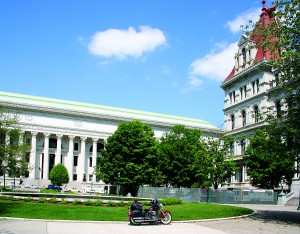
Leaving the river I went into the city, which is also the New York state capital, and found my way to Western Avenue. That is U.S. 20, and as it leaves the extended city it passes over the New York Thruway, aka Interstate 90, a modern toll road which brings the better part of $2 million a day to the state. The Albany-to-Buffalo portion of the Thruway opened in 1954, and traffic on U.S. 20 dropped by probably 80 percent or more that year; motorists were willing to pay the money to be in a rush, which I was not.
Suburbia stays behind, we enter the countryside, and the road drops into the Schoharie Valley, where we begin to find some signs of the Early Automotive Age. Coming up a slight hill, a collection of long-abandoned tourist cabins, probably dating from the 1930s, appears on the north side of the road. I look around—there is only one car in sight; U.S. 20 is not heavily traveled anymore. The road has really become a 300-mile museum of Eisenhower-era nostalgia, with the old motor courts and diners that the traveler with his Triumph Thunderbird or Indian Chief or Harley Hydra-Glide counted on half a century ago. The tourists may be rushing along the Thruway, but here the dairy farms and apple orchards still thrive.
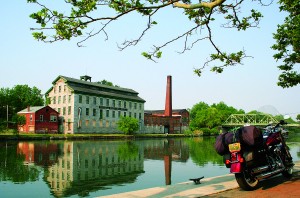
A little farther on is Sharon Springs, a hot-springs resort that was tremendously popular from the 1850s until the Depression came along. However, it is getting a chance at a comeback—one of the old establishments, the American Hotel, was renovated some five years ago and provides very handsome rooms and exceptional meals, (518) 284-2105.
The road roughly follows what used to be known as the Cherry Valley Turnpike. Cherry Valley, about 50 miles west of Albany, was settled way back in 1738 against the advice of the British military. A bloody little massacre occurred there during the French and Indian Wars because there weren’t enough soldiers to protect the town. You have to remember that, for England, the colonies were intended to be profit centers, and the folks in London did not want the colonists moving too far away from the tax collectors. It is nice to think that the American Revolution was all about freedom, but it was really about money. If the Brits had backed off on their tax collecting, there might never have been a revolution.
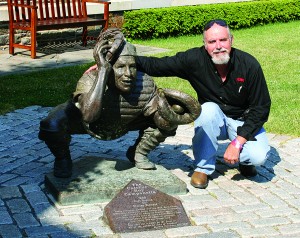
Once the revolution was over the new Americans wanted to expand, to have their own land. Cherry Valley boomed, and in 1799 some enterprising types built a toll road so the farmers could drive their produce to market in Albany or ship it to the continually growing New York City.
Southwest of Cherry Valley at the southern tip of Lake Otsego is Cooperstown, home to the Baseball Hall of Fame. Seventy years ago some enterprising Cooperstownian came up with the notion that the game was invented here, which is historically incorrect, but after the hall was established in 1939 the place has become a Mecca for every little leaguer. The town also has the impressive Fenimore Art Museum and the excellent Farmers’ Museum, founded in 1944, which accurately depicts rural life in the early 19th century.
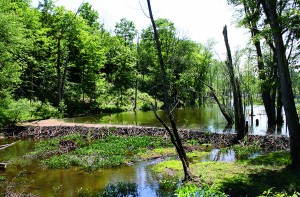
Back on U.S. 20 we enter Antiqueland. Between Bridgewater and Cazenovia are dozens of shops and barns displaying their wares. Station wagons and SUVs could be seen outside these places, loading up ladderback chairs and lead-lined ice boxes. It is a wonderful world we live in, where one man’s old stuff is another man’s treasure. Fortunately, the Softail does not have much carrying room, so I am not tempted.
I am tempted by Cazenovia’s Brae Loch Inn, an 1805 Victorian mansion turned into a very fine inn and restaurant 60 years ago. True to its Scottish name, you can find haggis on the menu, along with steak and kidney pie, smoked salmon and other delicious dishes. Contact the Brae Loch at (315) 655-3431 or www.braelochinn.com.
In the morning I come to Cardiff, settled by Welshmen long ago and named after the capital city of Wales. Here in 1869, one of the great 19th-century hoaxes was prompted when a local reported he had found a semi-fossilized body of a giant 10-foot human being, and made good money charging the curious 50 cents to see it. Even after it was admitted that it was a fake, the Rubes came to gawk.
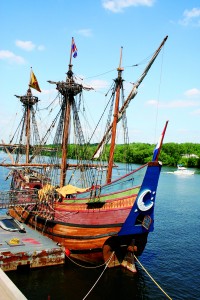
Now we are in the Finger Lakes region, where 10 or 12—depending upon who is counting—more or less parallel lakes were gouged out of the north-south valleys. Some are long, like the 50-mile Lake Cayuga, some very short, like Canadice and Hemlock. This is also grape-growing country, and the inevitable winemaking follows. The Dinerant, a shiny 1950s Buck Rogers diner-restaurant in Auburn, is the place to have breakfast.
Motoring on, we come to Seneca Falls and the Women’s Rights National Historical Park. Lincoln may have emancipated the slaves in 1865, and Congress may have passed the 15th Amendment concerning voting rights in 1870, but it took another 50 years for women to get the right to vote. In 1848, 300 women and men gathered here to make the first formal demands for the rights of women, but the 19th Amendment did not get ratified until 1920. Down along the Cayuga-Seneca Canal there is a statue commemorating the meeting of three activists in 1851—Elizabeth Cady Stanton, Susan B. Anthony and Amelia J. Bloomer—who were derided as radicals and troublemakers by the male-dominated press of the day.
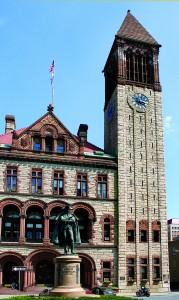
The Cayuga-Seneca Canal connects lakes Cayuga and Seneca and also links up with the Erie Canal, which parallels U.S. 20 farther to the north, running some 365 miles from Albany to Buffalo on Lake Erie. This mammoth construction effort ran from 1817
to 1825, and comprised 83 locks and 18 aqueducts, the latter a bridgelike affair used when the canal passes over a river or a valley. At that time the canal was 40 feet wide and 4 feet deep; after its last restructuring in 1918, it was 120 feet wide and 12 feet deep. Railroads and trucks put the barge traffic out of business, though the canal is still used by recreational boaters.
We pass through Avon, cross the Genesee River and move into corn and hay country, flat and fertile for 50 miles. The Buffalo sprawl then makes itself apparent, and in Depew U.S. 20 makes a hard left, continuing on its way to the Pacific Ocean. But the old Western Turnpike kept on straight, a road now designated NY 130, which becomes Broadway and runs right into the center of the city.
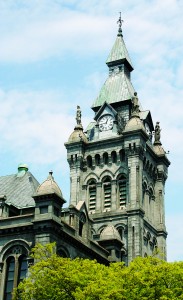
Nobody is quite sure how Buffalo got its name. Some say that herds of American bison used to hang around natural salt licks here. Others that it was a mispronunciation of the French “belle fleuve,” or beautiful river, as the Niagara River was called by explorer Robert La Salle who paddled by here in 1628. The French established a small settlement here in the 1750s, which the British took over following the 1763 Treaty of Paris, and after that the Americans lay claim to the place. Then the Brits burned the little community during the War of 1812. The Great Western Turnpike brought people west, and with the opening of the Erie Canal in 1825 the place boomed. The railroad arrived less than 15 years later.
Down on the waterfront is Naval Park Cove, where I park the motorcycle. Three World War II ships are moored here, a guided-missile cruiser, a destroyer and a Gato-class submarine, the USS Croaker—what an unfortunate name. The Croaker is about 40 times bigger than the Half Moon, and I could barely fit through the inside passageways. Go under water? Not this boy.
My trip across upstate New York has been an interesting way to spend two days, beginning and ending with ships. Curious, that—I suppose it will all make sense some day. Anyway, the upshot of this ride along the Western Turnpike is that I am very glad that I was not in a rush, or I would not have seen Cooperstown, nor eaten haggis.
[From the July 2006 issue of Rider]
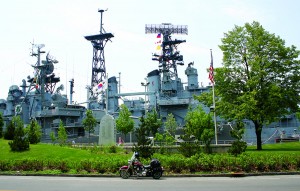 |
 |








The picture of the “colonnaded” building in this article is neither the county nor state court house. It is the former State Museum now housing the State Education Department. The “new” state museum is located in the modern Empire State Plaza.
Great article nonetheless.